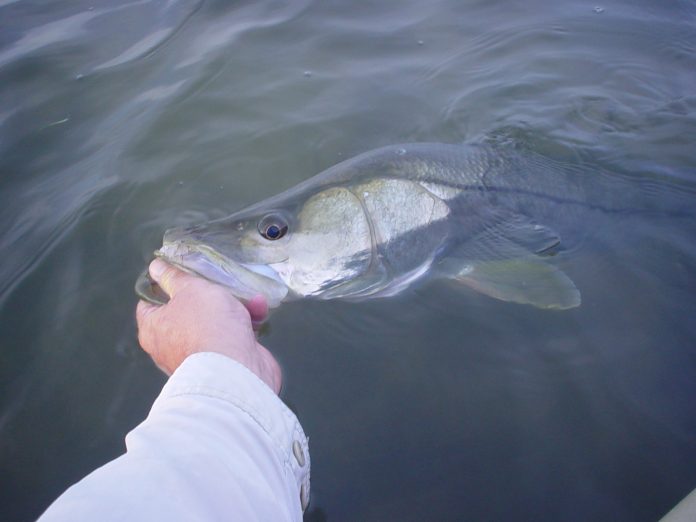
Sixwave Lures: The “Middleweight” jighead
By Neil Taylor, www.strikethreekayakfishing.com
Glenn Dunsmore was already making custom, hard-bodied wooden lures at the time I first met him. A local angler and participant on www.capmel.com popular fishing “forums”, Glenn kept his ears open for items that local anglers would like to use but can’t find. One particular item he came up with is a jighead that he is making, but most notable: One being made in a specific weight. The general jighead style he is making is exceptional (especially for using with 3-inch paddletails like the 12 Fathom Mullet). All previous jighead manufacturers made these in sizes of 1/16 then up to 1/8-ounce with the next heaviest option the one-quarter ounce jighead. Great jigheads for situation-specific uses, the Sixwave jigheads are available in 1/8-ounce, the “middleweight” 3/16-ounce and the 1/4-ounce.
For many years I had encouraged lure companies to consider producing the “3/16-ounce” jighead in a similar style jighead but to no avail. My contention was: In the shallows, the 1/4 is too heavy to be able to swim realistically at a slow enough pace without having it stick in the grass. The 1/8-ounce is a great option but it has some limitations. Trying to work a lure cross-wind with the rod tip up and the action of the lure diminishes significantly. For species like redfish, the action needs to be right. I believed that this “middle weight” in this style jighead would be absolutely ideal. Was I right?

People argued with me in the past that it was an unnecessary item. Getting these jigheads and working with them, it is exactly what I suspected all along: As a test, to compare this to the 1/8-ounce option: Rig up your paddletails on both weight jigheads and simply drop it in the water next to you and watch how it sinks. Move the rod tip, dragging them throuh the water to watch how both swim. But most importantly, cast it where there are feeding fish. Comparisons in testing how the Middleweight works versus the 1/4 and the 1/8 and “in action”, it is clear: The “Middleweight” is a winner and has its place in the tackle arsenal. Ideally weighted for nearly every situation, I believe that the Sixwave “Middleweight” will become one of the top-selling jigheads in a short amount of time.
More benefits of the 3/16-ounce Sixwave jighead:
Casts a couple of yards farther than the 1/8-ounce jighead.
Can be fluttered down in deeper locations faster than the 1/8-ounce jighead.
Swims perfect and true with a lowered rod tip and straight reeling retrieve, not leaning to either side like the 1/8-ounce jighead will do if it is retrieved at a faster pace.
Holds in the water column better with wind blowing on the line that is above the surface, maintaining good lure action. Available in the 1/8 and 3/16-ounce jigheads with a 1/0 hook, something other companies don’t offer.
Eyes painted onto every jighead for realistic baitfish look.

Construction and materials:
The Sixwave jighead is made with a premium quality Mustad (the 32786BLN – a black nickel needle point hook).
Powder coated with premium powder paints and baked, Sixwave offers their jigheads in the following colors:
•Red •Pearl White •Chartreuse Yellow •Copperhead •Root beer with red and gold flake.

Unlike other jighead companies, Sixwave sells their jigheads in a re-sealable bag, keeping unused jigheads dry for future use.
Pro Tips:
The 1/8 and 3/16-ounce options have a wider range of uses, particularly for the shallow-water angler. The 1/8 is going to be a great choice for jerkbait style tails in the shallowest turtlegrass areas and can be used in deeper areas with all tail choices by slowing down the retrieve.
Many anglers new to artificial lures are using “swivels”. Learn a good line-to-leader connection knot. Keep the action of the lure best by eliminating hardware but this will also:
A) Pick up fewer weeds and
B) Decrease the chances that fish will see your hardware and not strike your lure.
Using the fishing rod: When the lure gets closer to the angler, drop the rod tip for better action of the lure. When the lure is farther away, the angler can do different things with the angle of the rod tip and still have great action on their lures.
Using the other options:
The 1/8-ounce jighead is also a great weight and useful for the swimbaits like the 12 Fathom Mullet or similar style tail, particularly for the very shallow areas and times of lighter wind. It is also ideal for other styles like the SlamR, enabling the angler to glide their bait in the strike zone to connect with feeding fish.
The 1/4-ounce Sixwave jighead is useful in deeper water, particularly if there is current. It will help you to sink the lure down faster and keep it down when targeting deep-water trout, flounder, pompano or Spanish mackerel.
Get an assortment of these and try them out. And enjoy “The Middleweight”, a perfect option for a majority of your fishing needs!
To locate Sixwave Lure jigheads, send an email to contact@sixwavelures.com or go HERE for current dealers that carry Sixwave jigheads.
- The Neil Blog… - July 26, 2023
- The Catfish - July 26, 2023
- update - July 22, 2023











